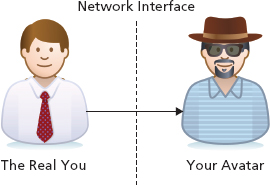Chapter 8
Avatars and the Social Seven
Unique Characteristics of Social Machines
When designing physical products, we concern ourselves with all the familiar issues that define, restrict, and organize our world. All physical objects have the same basic properties. They have dimensions—length, width, and height. They have weight and mass. They have important other properties such as color, texture, proportion, and even smell. We are intimately familiar with all these qualities because they make up the world we live in.
But what happens when you connect that product to the Internet? If all it will do is download data from the Web or some other Internet-connected server, then none of the social concepts we’ve discussed thus far will be of much use. On the other hand, if the goal is to truly design a social machine, then how your product appears on the network is important.
Figure 8.1 Network Interface Introduces New Attributes

Your product’s network “appearance” is what we’ve been referring to as an avatar. It is exactly similar to the avatars we use in current networked environments of humans. But instead of creating a digital representation of a person, we’re creating one for a machine. As the designer, how you do this will influence how well your product performs its social functions.
Referring back to our social bicycle example and considering both our primary customers and developers, ...
Get Social Machines: How to Develop Connected Products That Change Customers' Lives now with the O’Reilly learning platform.
O’Reilly members experience books, live events, courses curated by job role, and more from O’Reilly and nearly 200 top publishers.

